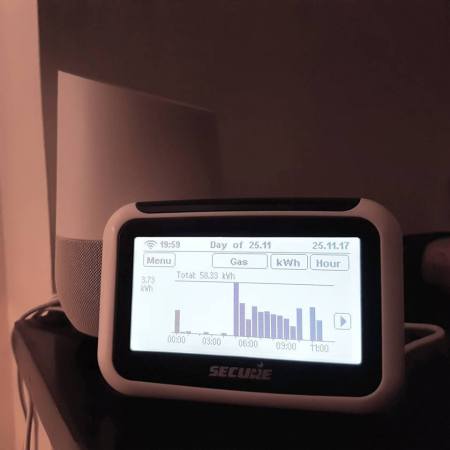Hello BIMfans,
Welcome to ‘Is It Smart?’, the blog series where I have a look at the smart technology installed within Tŷ Crempog to explore the power of BIM Level 2, PropTech, and the Internet of Things (IOT). This week, I take a look at Smart Meters.
Those of you who follow me on Twitter will know that I have been trying to get Smart Meters for a long time. In fact, I was put on Ecotricity‘s ‘priority list’ (Priority, Ha!) back in May 2016. It has taken almost 18 months to arrange and complete the installation, but now I finally have Smart Meters installed!
What is it?
Because of policy managed by the UK Government’s Department for Business, Energy & Industrial Strategy (BEIS), around 26 million existing homes might will have Smart Meters installed by the year 2020. These installations are being completed through the national energy providers. In my case, Ecotricity (eventually) arranged the installation through a licensed third-party, SMS Plc.
So, what is a Smart Meter? Well, a lot of excellent information is provided on the Smart Energy GB website on What Is A Smart Meter, as well as the Ecotricity website on What is Smart. In short, they are gas and electricity meters which communicate with a national energy supplier; removing the need to provide meter readings. They also provide real-time information about energy use, allowing the occupant (me) to better manage my energy. This is normally done through an additional appliance, the in-house display (IHD). Mine is currently sat in 002: Living Room next to my Google Home.

How does it work?
To be honest they are pretty straightforward. Smart Meters function in the exact same way as regular meters do but also have a sim card included. Mine are about the same size as my existing meters, so all SMS Plc had to do was do a straight swap.

Once installed, they effectively ‘text’ the energy use to my in-house display and to Ecotricity every 30 minutes or so. Note: After publishing this post, I was told about a few people who could not have smart meters installed because of poor mobile reception around their homes. It is a shame that they cannot connect to the internet.
How Did I Model It?
To fully capture this installation I needed to model two new objects. Under the Industry Foundation Class (IFC) Schema, electricity and gas meters are included under IfcFlowMeter. I had already modelled my existing meters, so using these I formed two objects based on the Smart Meters‘ overall geometry.
Due to the low level of graphical detail used, the object files are only around 300KB each. The files were named following the BS 8541-1 naming convention to:
Using the requirements set out in my Data Requirements, I populated these objects with the information needed to manage my Smart Meters. Within these objects, I have captured information such as: Installation information, barcode, and serial number.
When used in collaboration with my IFC Export mapping text file, my Smart Meters are populating all of the relevant COBie fields I require; fantastic.
Is It Smart?
Smart Meters barely tick any of the right boxes to be considered smart.
- Data In: With a direct connection to the flow of energy, they are able to consistently collect information. In addition, the in-house display can receive messages from the energy provider for the occupants, so it is able to receive data over the network too. However, there is no option to customize or inform it using any other information, so the input of data is quite limited.
- Data Out: With a mobile network connection, they are able to consistently communicate information. This information is also sent to the in-house display where it is stored for up to thirty days, allowing occupants to review historic energy use. However, there is no option to export this information, so the output of data is quite limited. Note: Researching online, the export of this information may become available in a future firmware update.
- Connectivity: Unfortunately, this is where it really falls short. There are no options to connect these devices. The connectivity is so poor, the readings don’t even appear in the official Ecotricity App.

The Potential
Much like my other smart products, there is no method to import information from my information model into my Smart Meters. For example, I’m sure that information regarding where they are in my home, as well as house type, room areas and the volume of my home would provide additional value to an energy provider.
However, the real potential is in getting access to the energy use data outside of the in-house display. If energy use data could be exported, I could then enrich it with local weather data and occupancy times; producing a rich dataset to form information about energy use patterns.
The Verdict

Is It Smart? The answer is No, with a shocking IQ of 50!
Since the smart meter roll-out was first announced, I knew I wanted to have Smart Meters for Tŷ Crempog. However, energy meters that simply project readings onto another display can hardly be considered smart. To be perfectly honest, the installation of these meters has had no impact whatsoever on how my home is managed. NOTE: Smart Meters have received a lot of criticism as they haven’t been producing the savings expected. It has also resulted in the Ecotricity App being uninstalled, as it no longer provides any valuable information.
And there you have it. This week my Smart Meters proved to be quite dumb. Tune in next time where we take a look at another piece of smart technology and ask one simple question; Is It Smart?

Pretty thick meters really then!
LikeLike